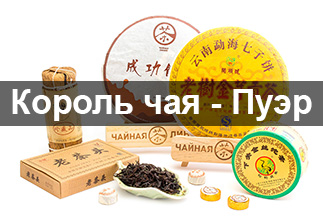The pancake is not pressed hard, and the raw material remains homogeneous when broken. The aroma of dry tea is restrained, elusive, and includes sweetish-spicy notes. The washed tea leaf has a rich, creamy aroma with a slight sourness, with hints of tree bark and cottage cheese casserole with nuts.
The taste of brewed tea has sweet homemade pastries, burnt caramel, figs, prunes and hazelnuts. The infusion is viscous, oily and soft. On the fourth infusion, the creamy-caramel notes are replaced by woody-nutty ones. Here are glazed hazelnuts, cocoa beans, dry tree bark. The aftertaste is airy, sweetish, with traces of cottage cheese casserole and hazelnuts.
Puer tea leaves in the amount of 5-7 grams, taken in a teapot made of Yixing clay with a volume of 150 ml, gave 6 full infusions.
The color of the infusion is dark red-brown with a noticeable burgundy hue. The infusion is clean and homogeneous.
Drinking tea with Shu Puer "Mengsun Laoshu" is accompanied by a strong and long-lasting effect. Old tea trees have been accumulating Cha Qi (tea energy) for years. The tea lifts the mood well, concentrates attention, helps to look at the world through the prism of positivity, self-confidence and calm. By the end of the tea drinking, it gives the body powerful energy, encourages a person to act.
This shu puer will be a great gift for both an experienced tea lover and a beginner. It has a good combination of creamy-woody notes, high-quality raw materials and a powerful effect.
|
Name in Chinese
|
勐宋老树 |
|
Pinyin
|
měngsòng lǎoshù |
|
Translation
|
Old trees from Mengsun |
|
Country
|
China |
|
District
|
Xishuangbanna Dai Autonomous Prefecture |
|
Provinces
|
Yunnan (云南) |
|
Manufacturer
|
Чайная Линия |
|
Raw material production date
|
2018 |
|
Year of pressing
|
2018 |
|
Pressing form
|
Bing Cha (Cake Tea) |
|
Type of tea raw material
|
Old trees (300-500 years) |
- Комментарии
- Вконтакте
Pu-erh is one of the most unique types of tea, which only gets better with age. Many people, when they first encounter this tea, wondered: why is pu-erh more often found in pressed form (cakes, bricks, tochas), and not in loose form? The reasons for this are related to both history and the practical aspects of storing and fermenting tea. Despite modern technologies that allow the production of loose pu-erh, the shape of pressed cakes remains unchanged. And pu-erh is more often found on sale in pressed form, for example, in the form of cakes or bricks, and loose pu-erh is less common. We will talk about the reasons for pressing pu-erh into cakes in this article.
Puer is a unique Chinese tea that is distinguished by its depth of taste, complexity of aromas and versatility of aftertaste. Its taste characteristics are formed under the influence of many factors, from growing conditions to the brewing method. Let's look at the main ones.
Over time, some consumers who are part of the country's "tea elite" discover mainland Chinese tea. And only a few get acquainted with Taiwanese varieties. The path of a tea person is usually long and thorny, but ultimately it leads to the King of Teas - puer. But not everyone is able to go all the way from ordinary teas to puer and appreciate its qualities.
The tea ceremony occupies a special place in the centuries-old Eastern tradition. And although the essence of this phenomenon remains constant, the nature and external manifestations of the tea ceremony in different nations have their own national characteristics. In each Chinese province, the tea ceremony and the tea used in it are varied: for example, residents of the southern provinces prefer green tea, and residents of the northern provinces - red tea, in Fujian province they more often use Oolong tea, and in Yunnan province Puer tea is widely known.






















































































